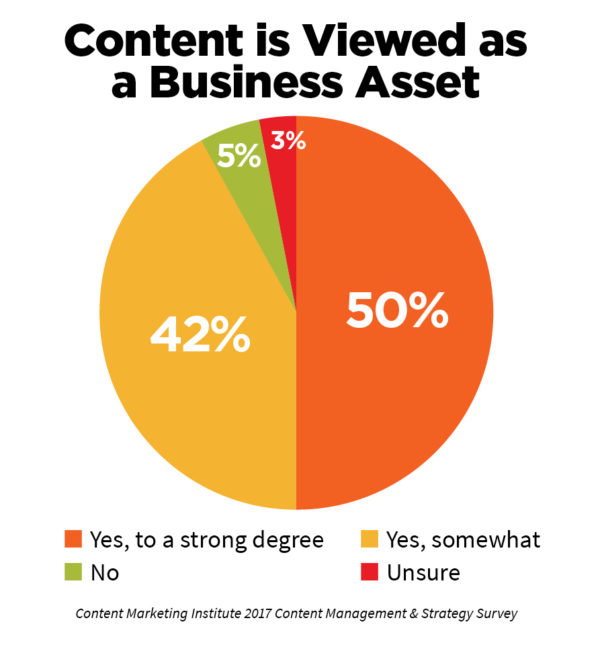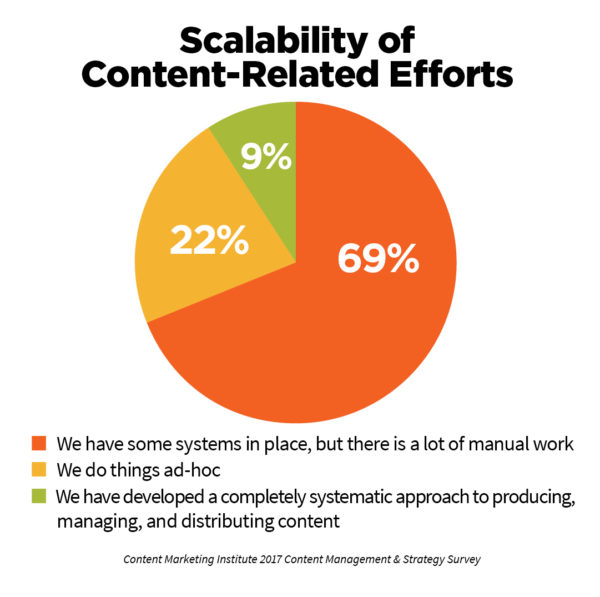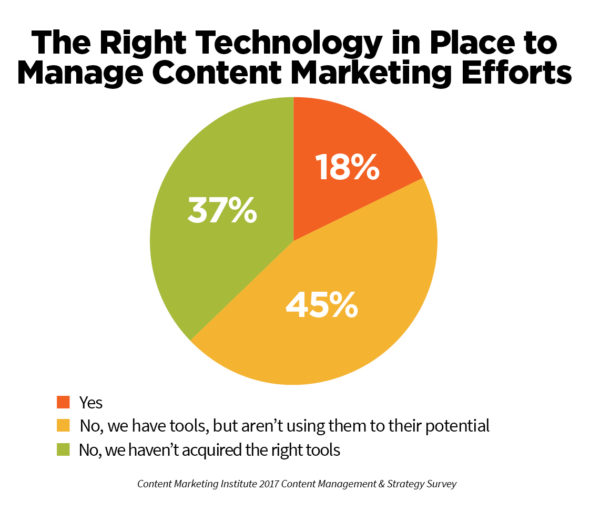
Think about the last time you went to a website looking for answers, and instead of stumbling upon something current and helpful, you found ROT – redundant, out-of-date, and trivial content. Did you poke around to find better info or did you go someplace else?
ROT occurs when you fail to plan what happens to your content after you hit publish and do the initial promotion. This one-and-done approach is costly to businesses – and, as your content library grows, it often makes the readers’ experience less than ideal.
If you come from the tech world, think about how the product is managed over the course of its life. Product managers address multiple stages including planning, creation, launch, updates, and retirement. Content professionals need to do this as well.
Where to begin? View content as a business asset – something that you need to manage strategically so you’ll get the best return on the content investment.
The good news is that 92% of respondents from the inaugural Content Marketing Institute Content Management & Strategy Survey indicate that their organization does indeed view their content as a business asset – “an asset or process where there is a direct investment and a goal of increasing value over time.”
92% of marketers say their brands view content as a business asset, according to new @CMIContent #research.
Click To Tweet
The bad news? Few marketers have the processes and tools to make this a reality.
Let’s dig in to the results to see what is going on – and, more importantly, let’s pinpoint opportunities for marketers to truly manage their content as a business asset.
How scalable are marketers’ efforts, really?
Marketers who manage their content as a business asset not only give their customers a better experience, but they also feel less stress because they have the systems and processes to create content in a scalable way.
Repeatable processes are essential so you’re not spending time figuring out how to do the work and have time to do the work. Systems also help eliminate the intensive time needed to recraft every piece of content by hand.
But, our research shows that only a small minority of marketers have the processes to be completely scalable.
A minority of marketers have the processes to scale content assets, according to new @CMIContent #research.
Click To Tweet
While this may seem like a bad thing, it’s a great opportunity for the marketers who figure it out. If you have the right processes, you are one step closer to creating better content, faster.
Want to Scale Up Your Content Operations? 4 Things to Think Big About [Infographic]
Opportunities abound for forward-thinking marketers
Document your strategy for managing content as an asset. Just as we talk about the importance of a content marketing strategy, it’s also essential to have a documented strategy for managing your content as a business asset. But only 46% of respondents have such a strategy.
Only 46% of marketers have a strategy to manage content as a business asset, says new @CMIContent #research.
Click To Tweet
While no one-size-fits-all template exists for creating a content management strategy, the next section talks about some structures you may want to document.
Have the right structures
Marketers must have numerous structures to effectively manage content as an asset. However, according to our survey, less than half of respondents have many of these structures.
Let’s look at each of these in order of how often they are currently used.
Style and brand guidelines
Most marketers have style and brand guidelines. These are key so everyone on the team represents your brand in a consistent way. Sasha LaFerte offers lots of details and examples in her post, How to Write a Style Guide for Your Brand.
Content teams
People, process, and technology. These are the three essential things you need – in that order – to have an operational and scalable content marketing program. While so much can be said about a team, start with this post that looks at the 10 key roles.
People, process, & tech are 3 things needed to have a scalable #contentmarketing program. @michelelinn
Click To Tweet
Formal workflow process
Once you have a team, you need to know who will do what. Rob Mills has a great post that outlines how to define your workflow, and Brian Watson’s post on how to find and conquer the bottlenecks in your workflow is a great follow-up.
Customer personas
Of course, you need to know all about your customer if you are to make meaningful headway – and these personas need to be shared across the team. Ardath Albee has a wonderful process you can use to create personas – or you can learn more about iterative personas, which aren’t as formal.
Content performance analytics
How do you know what content is working? There are so many ways to look at analytics, but every team needs to have a shared understanding of how success is measured. In a recent post, Mike Murray shared 101+ KPIs. You also can learn to use Google Analytics to uncover key insights about your content.
Customer journey maps
As Marcia Riefer Johnston explains, customer journey maps answer the question, “What content shall we create?” If customer journey maps are a fuzzy concept to you, read Marcia’s breakdown of what customer journey maps are and how to create them.
Structured content
I think of structured content as blobs or chunks or content that can be used in multiple applications. They are the basis of the create once, publish everywhere strategy, but you can benefit from having these content chunks even if your process is not as formal.
Message architecture / messaging framework
Message architectures are one way to get everyone on your team on the same page about what messages you want to deliver. As Marcia explains in my favorite post on the subject, a message architecture “tells them what messages their words (and images, etc.) should convey and the order of importance of those messages.”
Content governance
If you don’t know who on your team is responsible for which decisions or you want a better way to keep your content consistent and your processes efficient, you need digital governance. Here is an essential primer on the topic. You also can read how Intel has developed its digital governance program.
Content audit and inventory reports
I’m grouping content audit and inventory reports on purpose. The inventory report comes first, as it’s the list of all of your content, whereas the audit is an evaluation of that content. Paula Land provides a lot of explanation around these two concepts, and Cathy McKnight’s recent presentation at Intelligent Content Conference sheds a lot of light on audits.
Taxonomies
A taxonomy is essential for scalability because it organizes your content so related pieces can be surfaced. Blog post categories are an example of a simple taxonomy. Readers can click on a topic to see other posts that cover that same subject. Rachel Lovinger has some great ideas around the basics of taxonomies (and a close companion, metadata).
A taxonomy is essential for scalability because it organizes your content, says @michelelinn. #intelcontent
Click To Tweet
Story maps
If story maps are a new term for you, you can learn a lot from Robert Rose. As he explains, “The story map helps to organize your pieces of content across a timeline. It compels you to think of your content pieces as ‘chapters’ or ‘scenes,’ and can help reveal the gaps. It may resemble a high-level editorial calendar — but is structured with a focus on telling your complete brand story as you continue along your content development process.”
Consider how technology fits into the picture
Of course, not only do you need process, but you also need technology – the right technology. The good news is that technologies are available to make the labor-intensive processes go faster. Yet, according to our research, only 18% of marketers think their organizations have the right technology to manage their content marketing efforts. Another 45% say their organization has technology but isn’t using it to its potential.
This is another area where you have an opportunity to figure it out – and use in conjunction with a solid content marketing strategy – to leap ahead of the competition.
If you are wondering where to get started, consider the content marketing technology stack, which refers to the tools and technologies to enable marketers to do at least one of these things:
- Make content more effective (i.e., it helps them get better results)
- Reduce time spent on various workflow-related tasks
- Make more sophisticated marketing techniques possible (think: personalization or artificial intelligence, for instance)
As a reminder, before you jump into technology decisions, recognize that you need to have the right people and processes to implement and execute on the systems you choose.
While the use of technology in content marketing is a massive topic, here is one article to get you started: 7 Ways Technology Can Make You a Smarter Content Marketer.
30+ Marketing Tools for Research, Engagement, Measurement, Workflow, and Visuals
Conclusion
To see how your peers are approaching content management, read the entire report, Content Marketing Institute Content Management & Strategy Survey.
Editor’s note: A special thanks to Lisa Murton Beets, CMI research director, who created this research and helped with this post.
Sign up for our weekly Content Strategy for Marketers e-newsletter, which features exclusive stories and insights from CMI Chief Content Adviser Robert Rose. If you’re like many other marketers we meet, you’ll come to look forward to reading his thoughts every Saturday.
If you have expertise in this area, consider applying to speak at our upcoming Intelligent Content Conference. Call for speakers is now open until August 18, 2017.
Cover image by Joseph Kalinowski/Content Marketing Institute
The post Marketers: 14 Opportunities to Make Your Content Efforts More Scalable [New Research] appeared first on Content Marketing Institute.





No comments:
Post a Comment